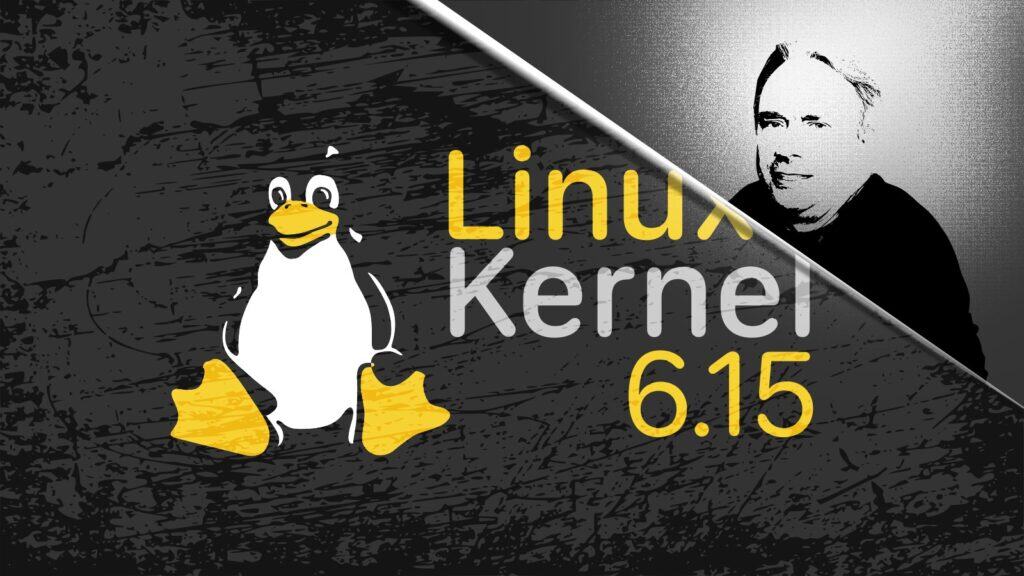After a brief delay caused by a late-breaking bug report, Linus Torvalds announced the official release of the new Linux kernel 6.15. It was held up for a few hours when a last-minute fix necessitated disabling one new feature at the eleventh hour.
Linux kernel 6.15: Core Enhancements
In this new release, support for hardware-wrapped inline encryption keys in the block layer stands out, enabling transparent disk encryption without software overhead. Likewise, the new “dmem” memory accounting cgroup enhances container and cgroup memory management by tracking device memory usage.
Under the hood, Linux kernel 6.15 refactors key locking and allocation primitives. For example, the per-VMA lock has been reimplemented as a reference count, reducing contention and simplifying code paths.
In the memory allocator, a new defrag_mode sysctl helps to avoid fragmentation, which is especially beneficial for workloads relying on huge pages. Additionally, the buddy allocator has seen hygiene improvements and faster fallback paths, boosting allocation efficiency.
File Systems
Bcachefs
Copy-on-write Bcachefs received support for flexible arrays in directory entries, enhanced scrubbing routines to detect and repair bitrot, and better checksum error handling. Device option handling and metadata versioning have been streamlined, while new debugfs interfaces allow more transparent monitoring of B-Tree updates.
Btrfs
Btrfs gains the ability to mount with negative Zstandard compression levels, offering finer tuning of space–speed tradeoffs. Defragmentation IOCTLs now accept compression levels, and the extent IO layer has been prepped for future large-folio support. Moreover, per-inode stable writes can now be exposed, aiding applications requiring strict write ordering.
F2FS
Flash-optimized F2FS takes its first steps toward a modern mount API, bolstering consistency and maintainability. A new ioctl provides IO priority hints, while extensive folio conversion work paves the way for more efficient page handling. Additionally, file-backed page reclaim now honors posix_fadv_noreuse, improving memory utilization in reuse-sensitive workloads.
Ext4 & XFS
Ext4 benefits from a linear search for dentries, faster superblock update intervals, and better error-mode behavior under errors=remount-ro. XFS, on the other hand, adds support for large atomic writes in copy-on-write mode, zoned devices, and a tunable threshold for zone garbage collection—features crucial for high-throughput storage arrays.
Networked File Systems
NFS and SMB clients see robustness improvements: containerized NFS teardown, client-side offload status tracking, and Kerberos 5 is now the default for SMB server authentication. Meanwhile, the CIFS side gets better handling of security descriptors and legacy 8-bit mode fixes.
Memory Management
Memory allocation and reclamation gain multiple refinements. The mremap() path has been refactored to eliminate a longstanding corner-case bug, while proactive reclaim statistics allow for smarter swapping decisions. The huge-page allocator now auto-tunes thread counts and integrates better CMA support. Other highlights include guard regions for file-backed mappings, split-out madvise() locking, and refactored mm-owner tracking for large folios.
Block Layer
The block stack sees full support for inline crypto keys, block devices can now advertise logical sizes larger than their physical media, and dm-cache can shrink its origin device on the fly. XFS IO maps have been updated for zoned block devices, and loopback devices now emit partition-related uevents, improving hotplug behavior.
Tracing, Performance, and BPF
BPF evolves with new instructions—load-acquire and store-release—enabling safer concurrent data structures in eBPF programs. The net-timestamp extension brings precise packet timing into user space, and new helper functions simplify socket options and CPUMASK handling. On the perf side, perf annotate can now show code with type annotations, histograms gain variable buckets, and latency/parallelism profiling enriches perf report.
Virtualization
Support for a /dev/mshv paravirtual root partition driver opens doors for Microsoft Hypervisor guests, while VFIO/VirtIO sees live-migration support for block devices. XenServer 6.1 platform devices are now fully recognized, and PowerShell-style CPU offlining is implemented for better host control.
Cryptography
The crypto subsystem continues its push toward high throughput and versatility. The ACOMP engine adds folio support, multibuffer hashing brings batch acceleration, and AF_RXRPC security now integrates Kerberos GSSAPI. The CRC libraries have been overhauled for modern instruction sets, nudging out legacy code.
Security
On the security side, landlock, the userspace-driven sandboxing LSM, gains expanded audit coverage and signal-scope corrections. Meanwhile, new LSM hooks for io_uring_setup() bolster container isolation, and SELinux now offers file/watch mount-namespace permissions and wildcard network-interface rules.
Networking
Bluetooth stacks add TX timestamping for ISO/L2CAP/SCO, while batman-adv jumbo-frame support enhances high-speed mesh networks. The DSA framework embraces Energy-Efficient Ethernet, and one-clock-per-PTP-device semantics simplify precision-time-protocol setups. TCP gets more tunables—such as tcp_rto_min_us and tcp_delack_max_us—and per-netns packet chains improve isolation for containerized workloads.
Architectures
Across ARM, RISC-V, x86, POWERPC, S390, and more, Linux kernel 6.15 adds new SoC and board Device Tree entries, chipset errata workarounds, and KVM enhancements. Notably, the Morello CHERI platform debuts a normal-mode DT, the Apple T2 BMC sees broadening support, RISC-V gains bfloat16 and extension flags, and x86 expands FineIBT-BHI protections.
Drivers
Graphics
Graphics also sees some additions. For example, Intel’s display engine gains dirty-rectangle support, AMDGPU welcomes DCN3.6 and custom brightness curves, and Apple display controllers receive first-class kernel support.
Power Management & Storage
ACPI fans can now report speeds even with limited firmware interfaces, while UFS, NVMe, and SCSI subsystems gain error-handling and multipath visibility features. The turbostat tool has been updated for 6.15, reflecting new frequency and temperature sensors.
Audio, Input, and Video
USB-audio picks up new vendor IDs, ASoC codecs refine Apple-variant quirks, and USB webcams implement UVC 1.5 ROI framing. On the input side, HID subsystems sync with udev’s BPF parser, and Apple Touch Bar drivers see expanded hardware coverage.
USB, SPI, and More
The USB core learns to parse eUSB2 descriptors; Type-C retimers like the Parade PS8830 gain support; and SPI controllers—from QPIC NAND to Sophgo—become more capable. Serial, GPIO, and PWM subsystems alike see new SoC and board hooks.
For those eager to compile the Linux kernel 6.15 themselves, it’s now available for download at kernel.org. As usual, rolling release distribution users will be the first to get the new kernel, with the update expected to hit their distros’ repositories over the next few days or weeks.
